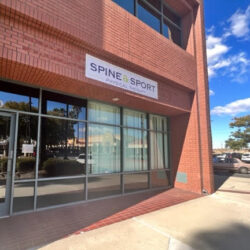The basics of physical therapy exercises
- There are many different types of exercise that are used for different purposes.
- The exercise program prescribed in therapy is designed to address the areas of concern found upon evaluation.
- Exercises prescribed by one of our therapists may include but are not limited to stretching, strengthening, cardiovascular endurance, muscular endurance, balance training and agility training.
- Our physical therapy team oversees the patient’s program, often recommending exercises that should be continued at home between appointments.
Move forward, faster, fearlessly
What to expect in a physical therapy exercise program
The exercises prescribed by a physical therapist are specifically designed to achieve a certain goal. Exercise programs are highly individualized depending on the injury and goals of the patient. Goals can range from improving knee strength to be able to get up the stairs to improving speed and agility to return to professional football. All treatment sessions are monitored by a physical therapist and a team of rehabilitation specialists to ensure safety and proper form.
Physical therapy focuses on helping patients move better and feel better. Often, someone is referred to physical therapy after experiencing an injury, surgery or other medical condition because they are experiencing pain or difficulty with normal mobility. A physical therapist can prescribe treatments and exercises for recovery as well as tips and techniques to modify daily movement to prevent injuries, pain or issues from occurring in the future.
Our physical therapy team will often prescribe exercises for the patient to do at home in between PT appointments. Telemedicine appointments are also available in between sessions.
Types of exercises used in physical therapy
When a physical therapist prescribes exercises, they are specific movement strategies to help the body change and grow in a positive way for that individual. This typically includes a combination of stretching, strength training and balance training techniques to help them recover or regain mobility.
Exercises are often coupled with other physical therapy strategies such as patient education, manual techniques or other pain relieving modalities to further rehabilitation.
Exercise regimens are tailored to an individual’s needs, ability and goals. Physical therapy exercises may include:
- Exercises to improve strength.
- Exercises for vertigo and dizziness.
- Balance exercises.
- Cardiovascular exercises.
- Exercises to improve flexibility, mobility and range of motion.
Strength training
Strength training exercises are prescribed to build muscle mass and may include using resistance with weights, resistance bands or one’s own body weight.
Strength training frequently complements other forms of physical therapy to reinstate the body’s flexibility, strength and stability. A physical therapist will develop a training program tailored to a patient’s goals, as well as teach proper lifting and form to ensure no injury.
Following strength training, people often feel soreness in their muscles for a day or two afterward. This is normal and is known as delayed onset muscle soreness (DOMS). This means that muscles are getting stronger and the exercises are working! As patients continue to improve their strength, the soreness will go away and they will start to feel fitter and stronger.
Core training
Like strength training, core training aims to increase muscle but focuses specifically on the central muscles of the body, or the “core.” Strengthening a body’s core helps to improve function and is useful for many different purposes including reducing back pain and improving posture, balance and athletic performance.
Balance training
Balance is important for everything that we do, from activities of daily living, such as walking and standing, to higher level athletic activities. Depending on an individual’s needs, balance exercises can be prescribed to make someone feel more steady on their feet, prevent falls, or improve athletic performance.
Stretching and flexibility training
Stretching helps to maintain proper muscle length and joint range of motion in order to optimize the body’s movement. This is important for everyone, and stretching exercises are prescribed for many reasons such as increasing joint range of motion after surgery, improving posture, maintaining proper muscle length in running athletes, or decreasing the discomfort from a muscle cramp.
What to expect from physical therapy
Whether recovering from injury or looking to gain function, exercises prescribed in therapy will center around an individual’s short- and long-term goals. After an initial assessment, an individualized plan for treatment and education is developed to keep patients on track.
During treatment, physical therapists will continue to assess a patient’s current level of movement and function and their progress toward goals. Adjustments are made throughout the plan of care to maximize effectiveness and ultimately achieve the goals that were set at the beginning of therapy.
Get informed
Speak to a physical therapist today about the right exercise regimen for you and learn more about injuries we treat.
[getpp func=”get_pages” include=”26,60,28″ template=”blog” attributes=”title,image,excerpt,readmore”]
Spine & Sport clinics offering physical therapy near me
All of our clinics in Southern & Northern California offer physical therapy exercises.
 South San Diego County
South San Diego County Central San Diego County
Central San Diego County East San Diego County
East San Diego County North San Diego County
North San Diego County Orange County
Orange County Imperial County
Imperial County Coachella Valley
Coachella Valley Riverside County
Riverside County Ventura County
Ventura County Los Angeles County
Los Angeles County Northern California
Northern California